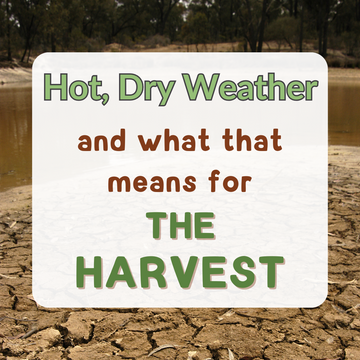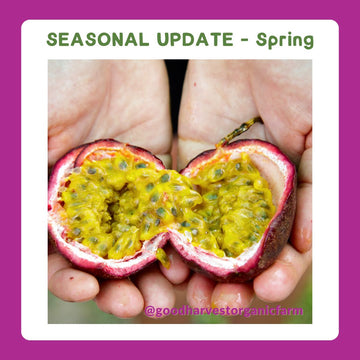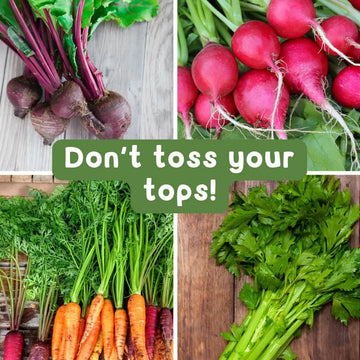A hot, dry summer ahead 🥵
I feel like as farmers sometimes all we talk about is…. The weather! Too hot! Too cold! Too dry! Too wet!
In reality it is such a massive part of what we do. Talk to any farmer across the country, probably even world-wide, they’ll regale you with tales of the weather and all the ways this impacts their harvests.
Australia is a country typified by its extreme climatic variations. The last few years have seen these variations intensify.
It’s often too hot, too rainy, too frosty, and too dry. What it comes down to is that it’s not predictable and not what you expect for the season.
Sometimes it’s hard for people to stay connected to the seasons and weather changes, especially if you’re at home on town water and not noticing a whole lot of difference in your local environment.
Spending a week in nature or on the farm will bring you face to face with the reality of weather impacts, be it good, or not so good.
Mick is also a media spokesperson for the Farmers for Climate Action group, meaning he gets all the latest insights and reports in terms of the impacts of weather and climate related events on farming.

It’s good to be informed, but it also means he sees first-hand the impacts of weather, not only on his farm, but on others too.
La Niña
So, we know that in 2021 and 2022 we were in a La Niña weather pattern, meaning higher than average rainfalls.
Remember those crazy floods in February 2021! Our paddocks flooded three times!
Directly following those floods, the average daylight hours dropped to as low as 4 hours per day. It was cloudy for over a month, so even when we managed to re-plant for the third time, things weren’t growing because of a lack of sunlight.
Well now, we’re on the total flipside of this!
El Niño
The BOM has declared in mid-September that we are now in El Niño conditions which is generally classified as hot and dry weather on the east coast caused by sea surface temperature differences in the pacific.
This is coupled with a strong positive Indian Ocean Dipole (IOD) which also brings hot dry weather from the west.
It’s been building since May, with the majority of the country experiencing rainfall deficiencies.
The start of spring this year heralded the start of the impacts of El Niño – with the entire country receiving 70% less rainfall than average, our driest September on record (since 1900). September was also the fourth month in a row of record-warm global temperatures.

Source: http://www.bom.gov.au/climate/ahead/outlooks/archive/20231005-outlook.shtml
Not only is our rainfall 70% less than average (meaning our dams are dry), but our soil moisture content is also well below average (in the lowest 30% of all years since 1911). Of course, our farming methods help retain soil moisture and structure, but with such dry conditions, there is only so much we can buffer against.
The predictions are grim. It’s expected that between November 2023 and January 2024, we are to receive between 60-80% less rainfall than expected. Beyond January, they expect hot and dry conditions to continue through to Autumn.
The combination of El Niño and the IOD mean that rain is essentially drawn away from Australia. It also means hotter temperatures – a signature of El Niño is extreme temperature shifts like heatwaves.
These intense conditions not only mean less rainfall and high temperatures, but the combination of these means a significant risk of bushfires.
Side note: El Niño is part of a natural climate cycle that affects global weather and occurs on average every three to five years. What we are noticing is that due to increased climate change impacts, El Niño (and even La Niña) are becoming more extreme.
So what can we do?
As farmers, we have to prepare for a dry, hot future, which means assessing our crop plan and determining what we can grow over summer and into Autumn. We’re also finding ways to reduce our water needs as much as possible.
We’re working and communicating with our farming friends country wide to ensure we can all support each other during these challenging times.
It is why we are so grateful you choose us to feed your family.
Knowing we can work with a network of organic farmers and directly support their livelihood and guarantee demand for their produce is super important.
It keeps our country growing.
If one farmer needs to rest their fields or has a break in production, we can all work together to ensure continued supply for our community and be ready for when their harvests start again.
They say it takes a village to raise a child, and this statement is certainly as true for feeding a community.

It takes a strong collaborative network of passionate growers to feed our community each week.
The model of all for one and one for all is very much how we operate at Good Harvest, and how we believe our food system should be directed.
You can do your part by continuing to support farmers, growing your own produce at home, and managing your own water use over the coming months.
Thanks for coming along on this journey with us!




